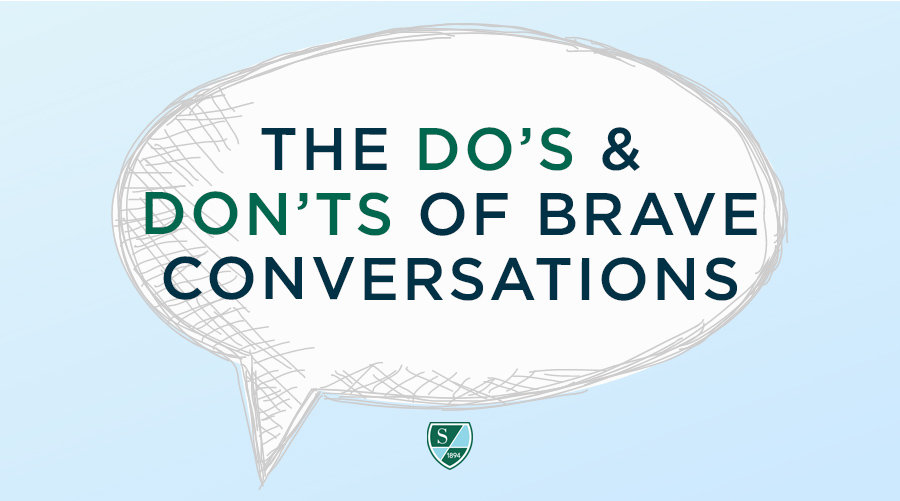Kids need us to be brave so that they can be brave. When I’m feeling fearful and uncomfortable, that’s usually the biggest sign that my students need to have the very conversation I’m afraid to have. This resource, which I call “The Do’s and Don’ts of Facilitating Brave Conversations with Kids,” is a compilation of best practices that I call myself to return to when I’m opting for a silence. I invite all educators and caregivers to join me in this charge.
In the months following the July 2013 acquittal of George Zimmerman for the killing of Trayvon Martin and as the Black Lives Matter movement was gaining momentum, I remember feeling paralyzed with fear that my students were going to ask me questions about the verdict. I didn’t know the intricacies of the case and I didn’t want to spread misinformation. Worse, I didn’t want to say something that would offend or harm any of my students, most of whom were Black. I chose to say nothing. I put my head down and plowed ahead with our unit on Of Mice and Men. In short, while the children under my care were experiencing racial stress and trauma, I chose silence out of fear.
I’ve learned a lot since then. I’ve read the research on how ignoring race and racism does violence to Black and brown children’s mental health. I know better and I’ve done better. And yet only two weeks ago, after nearly a decade of engaging in a professional anti-bias/anti-racist practice, I again chose silence when I opted not to discuss the violence in Gaza with the members of my Race & Identity Club. The group is multiethnic; it includes students who are Jewish and Muslim, and I didn’t want to spread misinformation, especially about a topic I knew even less about than race and racism in America. And just like in 2013, I didn’t want to offend or hurt my students or their families.
After the Race and Identity meeting (the one at which I chose not to discuss Israeli-Palestinian conflict and instead focused on what designs we would want on a sweatshirt for our Club), one of the members approached me. He said, “Mrs. Corgan, I want to let you know that some students are assuming that we’re not allowed to talk about the situation in Gaza right now because we thought you’d bring it up today but you didn’t.” My silence and sent a loud and clear message to the kids: the fear, pain, anxiety, and confusion you may be feeling right now is off-limits.
I sent an email to Race and Identity members shortly after and said that we’d be discussing the crisis between Israelis and Palestinians at our next meeting. At that meeting, not only did everyone show up, but multiple students who had never attended any of our prior meetings came. We ran out of chairs because word spread about the meeting topic. As we sat in a circle and bravely processed painful and complex current events together, the comment that resounded most was “We’re confused about what’s going on in Gaza and we’re even more confused about why our parents and teachers aren’t talking to us about our confusion.”
Together, let us be brave and responsible, using the following suggestions as a guidepost.
Do!
- Increase Self-Awareness: understand your own beliefs, biases, privileges, and responses, because this is an essential foundation for facilitating discussions with students. A good starting point is to take the Implicit Association Test (Project Implicit, 2011).
- Set up Group Guidelines: It is critical to set up agreements to promote a classroom environment that is safe, respectful, and allows for mistakes. Do this collaboratively with students to address: listening and interrupting, how to deal with strong emotions, establishing trust, confidentiality, sharing, “air time,” and dealing with disagreements.
- Role-Play: With trusted colleagues, practice facilitating mock conversations with students. Form a “buddy system” to practice, using trauma-informed and culturally-responsive language. Give and receive feedback.
- Provide Opportunities for Student Leadership: Some examples might include students facilitating class discussions or making messages of equity and inclusion more visible on school grounds.
- Clarify Misinformation: Stick with facts as simply as you can. Check in to hear what children think they have heard from you.
- Consider the Racial Composition of your Classroom: If you don’t have any students of color in your classroom, find ways to include other voices. Additionally, understand that one’s perspective is shaped by their own racial background as well as other aspects of our identity. Therefore, white students and students of color may not see a situation in the same light; within racial groups there will also be diversity of perspective.
- Address White Privilege: This term can produce anxiety and defensiveness among white people, but if students are going to be able to engage in conversations about race, privilege has to be on the table. The goal is not to make anyone feel guilty but rather to understand the ways bias manifests itself in individuals, institutions, and systems.
- Connect Present Events to our Past: When you discuss current incidents of racism and injustice, ground the discussions in a historical context where relevant. For example, the murder of the Charleston nine requires a lesson about the Confederate flag.
- Think Critically about Text and Media: Assist students in analyzing media portrayals of racial incidents in the news. This includes exposing them to a wide variety of sources that illustrate different perspectives. Reflect on the implicit messages you convey to your students about race by what’s on your walls and bulletin boards.
- Inspire “Critical Hope” and Activism: It’s important that we don’t leave our students with overwhelming feelings of hopelessness and despair. At the same time, we don’t want to fill their heads with false or empty hope. Provide examples of social justice triumphs and support your students in planning any efforts for social change.
Don’t!
- Do Nothing: Teachers may opt for silence in the midst of racially heated talk, exhibiting behavioral and emotional passivity in their own actions. Studies suggest that although adults are feeling powerful emotions and anxiety when dialogue on race occurs, they feel paralyzed, inept, and/or confused about how to intervene, which leads to a deep sense of personal failure. More problematic is that their inaction suggests to students that race talk should be avoided and worse, racism is normalized.
- Quash the Discussion: When a conversation threatens to get out of control, one of the most common actions to table the discussion without carrying through on the promise to return to the issue later. Another strategy might be to ask the students to discuss the matter outside of the classroom, or stress that the students should calm down and discuss the topic in a rational manner. While we certainly want to follow discussion guidelines, we do not want to suppress natural dynamics of deep conversation.
- Teach vs. Guide: Facilitation differs from typical lecturer/student dynamics. The best facilitation allows everyone (including the facilitator) to learn from one another. Students may naturally look to you as an “expert.” One way to bypass this is to open the question up to the group: “What do you all think?”
- Use an Either/Or Mindset: Help guide students away from thinking that they’re all right or all wrong, or either for us or against us. Dr. Ibram Kendi explains that “to be anti-racist is to admit when you’re being racist.” Therefore, when discussing inequity, it’s helpful to focus on power and policy, not people.
- Make it up as you Go: Practicing racial literacy is a process and there will be times when we are stumped. A student may ask a question and we may not entirely understand or know how to answer. In a moment like this, it’s important to say “I don’t know” and then return to the conversation once we’ve actively done the learning for ourselves and/or with others.
- Put Students on the Spot: It is inappropriate to cold-call during race and racism-based conversations. Specifically, do not assume students of color want to share their experiences or are knowledgeable and skilled about talking about race. Further, do not place those students in the position of being the “authority” of knowledge about race, as Black people are not a monolith.
- Avoid Discomfort: In many cases, it might help to say out loud what you and others may be feeling. Demonstrating your own vulnerability often opens the door for your students to be vulnerable, as well.
- Take Symptoms of Trauma Personally: Racial trauma refers to the stressful impact or emotional pain of one’s experience with racism and discrimination (Carter, 2007). Common traumatic stress reactions reflecting racial trauma include increased vigilance and suspicion, increased sensitivity to threat, sense of a foreshortened future, anger, withdrawal, distance, and/or irritability. Help students identify their emotions through discussion circles or individual writing prompts.
- Fill the Silence: It can be uncomfortable to let the silence lie, but it can also be an important moment in the larger arc of the conversation.
- Ignore your own Wellbeing: Facilitating difficult conversations can be emotionally draining or even painful for teachers. Make time to process, reflect, and recharge in positive ways. Take advantage of professional learning communities where you can discuss the dynamics of your classroom.
Learn more about Diversity, Equity & Inclusion at The Shipley School.
References
Derald Wing Sue, “Facilitating Difficult Race Discussions”
Learning for Justice, “Let’s Talk!”
Repair the World, “Guide to Respectful Conversations”
National Association of School Psychologists, “Understanding Race and Privilege”
Anti-Defamation League, “How Should I Talk about Race in my Mostly White Classroom?”
Ibram X. Kendi, “How to be an Anti-Racist”
National Child Traumatic Stress Network, “Addressing Race and Trauma in the Classroom”










